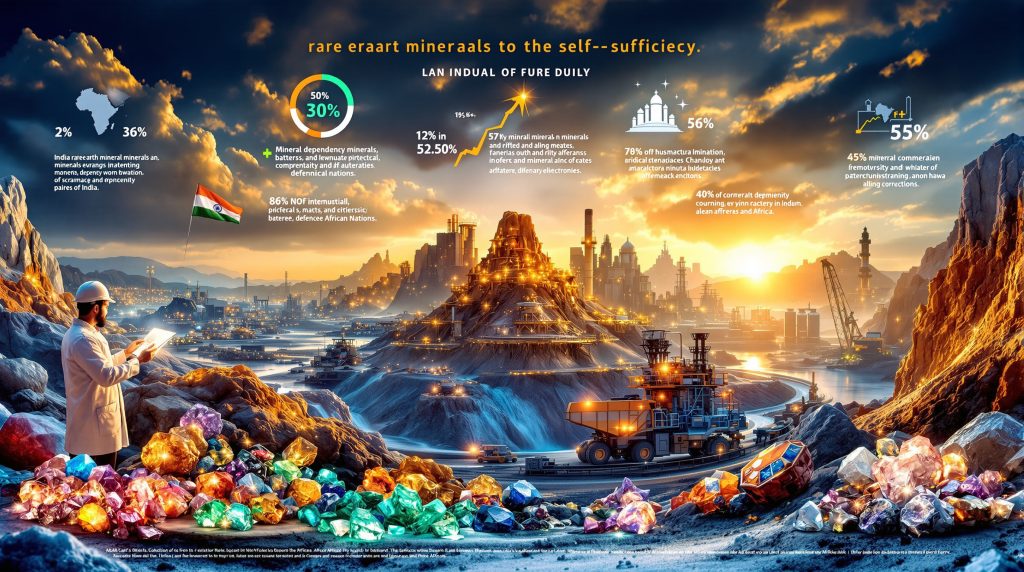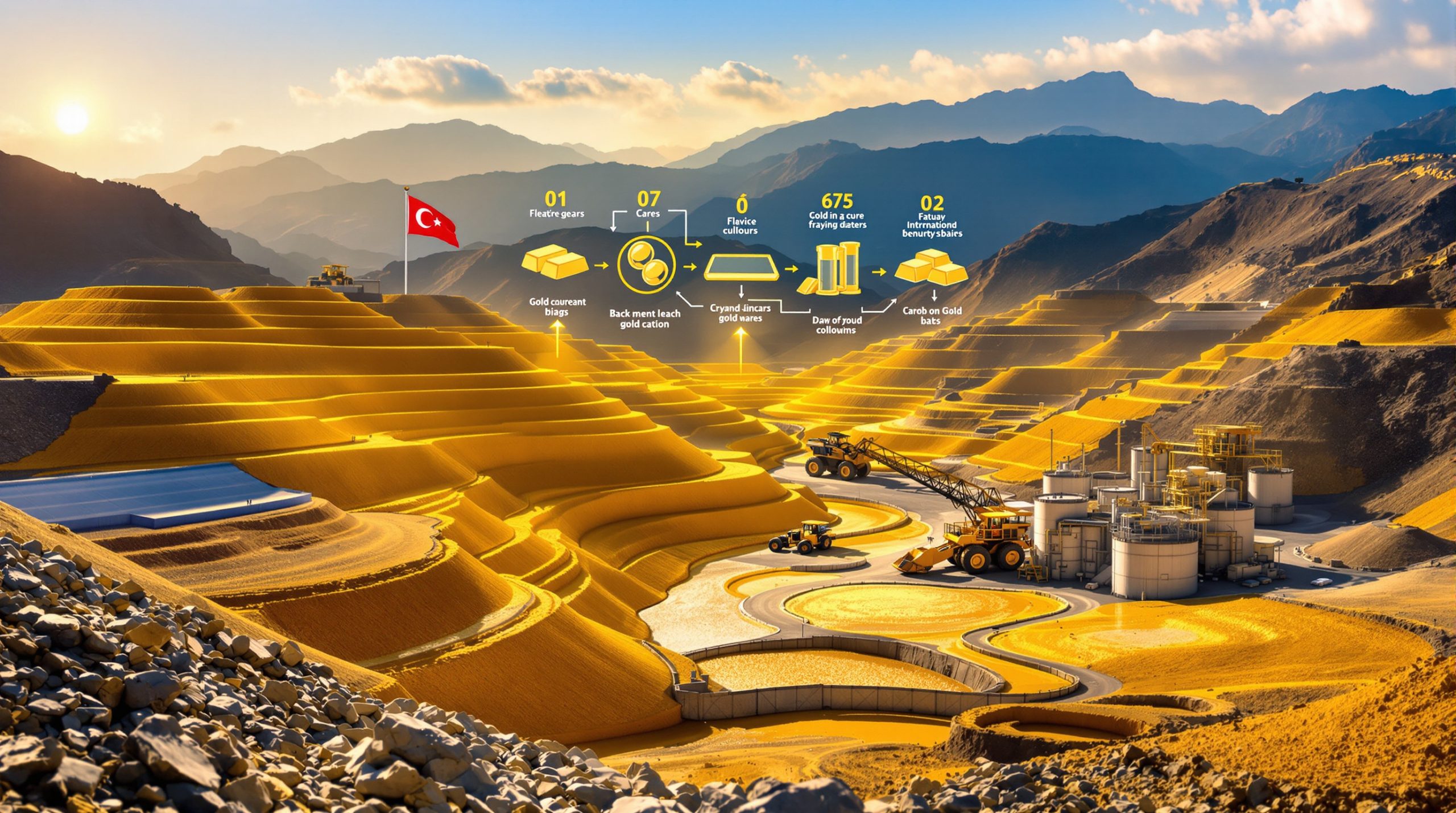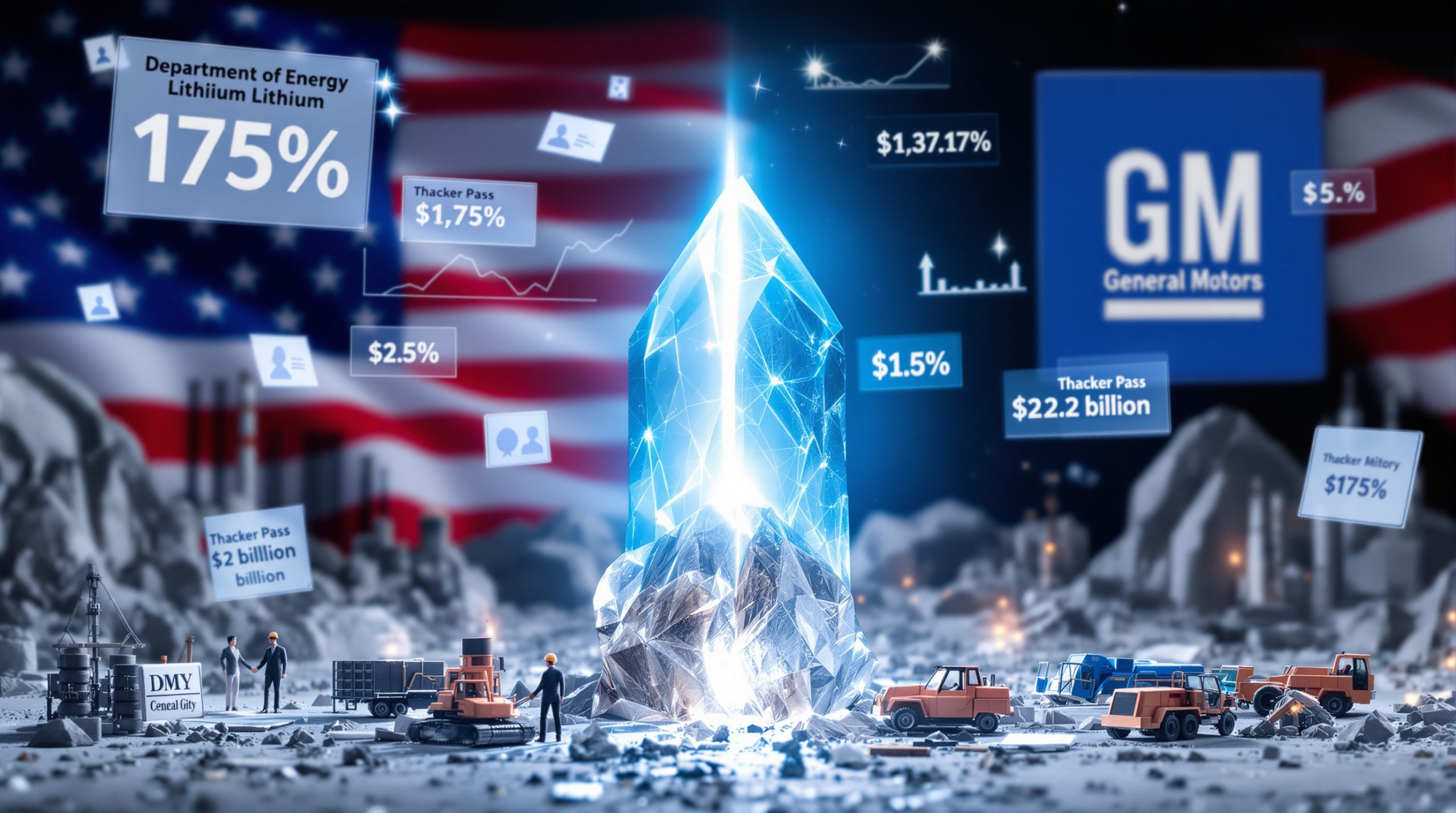India's Path to Critical Minerals Self-Sufficiency: Strategies and Challenges
India stands at a critical juncture in its industrial development, with its ambitious vision for technological advancement, renewable energy transition, and manufacturing growth all hinging on one crucial factor: securing reliable access to critical minerals. These specialized resources form the backbone of modern economies, and India's push toward critical minerals self-sufficiency represents one of its most significant economic security challenges of the 21st century.
The Strategic Importance of Critical Minerals
Critical minerals encompass a group of elements and materials that are essential for modern technologies yet face supply risks due to geological scarcity, geopolitical tensions, or market concentration. These include lithium, cobalt, rare earth elements, nickel, graphite, and several others that form the foundation of everything from smartphones to solar panels.
For India, these minerals represent the building blocks of its technological future. Rare earth elements enable the powerful magnets in wind turbines and electric vehicle motors. Lithium, cobalt, and nickel are essential for advanced battery technologies. Gallium and indium support semiconductor manufacturing and solar technologies.
Beyond clean energy, critical minerals are vital for India's defense sector, supporting advanced radar systems, communication technologies, and precision-guided weapons. They're equally crucial for the country's burgeoning electronics manufacturing industry and high-tech industrial applications.
India's ambitious targets—500 GW of renewable energy capacity by 2030, 30% electric vehicle penetration by the same year, and becoming a global manufacturing hub—all depend on stable, affordable access to these energy transition minerals.
India's Current Dependency Challenges
The reality of India's critical minerals situation presents significant challenges. The country currently imports over 80% of its critical mineral requirements, creating economic vulnerabilities and supply chain risks that could undermine its industrial ambitions.
This import dependency has substantial economic implications. Price volatility in international markets directly impacts manufacturing costs and project viability across multiple sectors. During recent supply disruptions, certain rare earth prices increased by 200-300% within months, demonstrating the financial risk of dependency.
The geopolitical dimension is equally concerning. China controls approximately 85% of global rare earth processing capacity and significant portions of other critical mineral supply chains. This market concentration creates strategic vulnerabilities that extend beyond economics into national security considerations.
As highlighted by Saloni Sachdeva Michael from the Institute for Energy Economics and Financial Analysis (IEEFA) in a recent CNBC Inside India segment, this dependency requires a comprehensive strategy: "India's three pillars of domestic exploration, international partnerships, as well as stockpiling and recycling of critical minerals, all put the country on the right track to achieve self-sufficiency in critical minerals."
How Is India Developing Its Critical Minerals Strategy?
The Three-Pillar Approach to Self-Sufficiency
India has formulated a comprehensive strategy built around three interconnected pillars to address its critical minerals challenges.
The first pillar focuses on accelerating domestic exploration and mining initiatives. The Geological Survey of India has intensified efforts to map potential mineral deposits across the country, particularly in states like Odisha, Jharkhand, and Rajasthan. These efforts employ advanced geological survey techniques, including airborne geophysical surveys and deep-earth imaging technologies.
The second pillar involves establishing robust international partnerships and supply agreements. India has recognized that complete isolation from global supply chains is neither practical nor desirable. Instead, it seeks to diversify its sources through strategic agreements with countries rich in critical minerals.
The third pillar encompasses stockpiling and recycling programs. The government has initiated plans to create strategic reserves of essential minerals to buffer against supply disruptions and price volatility. Simultaneously, significant investments are being made in recycling technologies to recover valuable minerals from electronic waste, industrial residues, and end-of-life products.
According to IEEFA's Saloni Sachdeva Michael, this balanced approach is essential, recommending that "every country should still adopt a collaborative, not isolationist, approach in order to diversify their critical mineral supply chains."
Policy Framework and Government Initiatives
Supporting these three pillars is an evolving policy framework designed to attract investment and accelerate development across the critical minerals value chain.
The Mines and Minerals (Development and Regulation) Amendment Act of 2021 represented a watershed moment, removing distinctions between captive and non-captive mines and allowing transfer of mining leases. These changes aim to increase private sector participation and operational efficiency.
The Critical Minerals Mission, launched in 2023, coordinates efforts across ministries and stakeholders with specific targets for reducing import dependency. This mission-mode approach provides focused direction and accountability for achieving mineral security goals.
Financial incentives have been structured to address different stages of the value chain. These include exploration incentives through the National Mineral Exploration Trust, production-linked incentive schemes for manufacturing, and special funding mechanisms for processing facilities.
Regulatory reforms have simplified clearance processes while maintaining environmental standards, reducing the timeline for approvals from 3-5 years to approximately 1-2 years in many cases.
What Domestic Resources Does India Possess?
Mapping India's Critical Mineral Potential
India's geological diversity offers promising potential for critical mineral discoveries, though much of this potential remains underexplored compared to other major mining nations.
Recent geological surveys have identified significant potential for rare earth elements in the monazite sands along coastal regions of Kerala, Tamil Nadu, and Odisha. These deposits are estimated to contain approximately 35% of global monazite reserves, though extraction and processing capabilities remain limited.
The eastern Indian Shield region, particularly parts of Jharkhand, Odisha, and Chhattisgarh, shows promise for nickel, cobalt, and platinum group elements. Preliminary assessments suggest these areas could significantly reduce India's import dependency for these minerals if properly developed.
The Himalayan belt presents opportunities for lithium, with recent discoveries in Jammu and Kashmir suggesting potential deposits that could support domestic battery manufacturing. However, these findings require further validation and assessment of commercial viability.
Technological advancements are accelerating India's exploration capabilities. Hyperspectral imaging from satellites, drone-based magnetic surveys, and artificial intelligence for data analysis have all been deployed to improve discovery rates and reduce exploration costs.
Challenges in Domestic Extraction
Despite promising geological indicators, India faces significant challenges in translating mineral potential into production reality.
Environmental concerns present legitimate constraints, particularly as many potential deposits lie in ecologically sensitive areas. The need to balance mineral extraction with conservation requires sophisticated environmental management systems and strict compliance with sustainable mining practices.
Land acquisition and community engagement issues often delay project development. Mining projects affect local communities, raising concerns about displacement, resource access, and equitable benefit sharing. Successful projects increasingly require inclusive approaches that address community needs and ensure local economic benefits.
Technical challenges in mining and processing present additional hurdles. Many critical minerals occur in complex geological formations requiring specialized extraction techniques. Processing these minerals to meet purity requirements for high-tech applications demands substantial technological capability and investment.
For India to realize its domestic mineral potential, these challenges must be addressed through innovative regulatory frameworks, community partnership models, and investments in technical capacity building.
How Are International Partnerships Strengthening India's Position?
Strategic Bilateral Agreements
Recognizing the limitations of domestic resources and the global nature of mineral supply chains, India has pursued strategic bilateral agreements with key resource-rich nations.
The Australia-India Critical Minerals Partnership, formalized in 2022, represents one of the most significant developments in India's international mineral strategy. This partnership provides Indian companies preferential access to Australian lithium, cobalt, and rare earth projects, backed by financing support from both governments. The first investment under this framework was announced in early 2023, focusing on lithium projects in Western Australia.
Collaboration with African nations has expanded India's resource access opportunities. Agreements with countries like South Africa, Namibia, and Zimbabwe focus on technical cooperation, joint exploration, and investment facilitation for minerals including platinum group metals, cobalt, and manganese. These partnerships can provide valuable mineral beneficiation insights for India's growing processing sector.
India has also established agreements with South American lithium-producing countries, including Argentina and Chile. These agreements facilitate Indian investment in the "Lithium Triangle" region that holds approximately 60% of global lithium resources. Indian state-owned enterprises have secured exploration rights and offtake agreements to ensure supply chain security for battery manufacturing.
Multilateral Cooperation Frameworks
Beyond bilateral agreements, India is increasingly active in multilateral frameworks addressing mineral security.
India's participation in the Minerals Security Partnership (MSP), alongside the United States, Japan, Australia, and European partners, coordinates investment and development assistance for responsible critical mineral supply chains. This framework enables risk-sharing for major projects and alignment of environmental and social standards.
The country has also joined supply chain resilience initiatives focused on critical minerals, including the Indo-Pacific Economic Framework and Quad Critical and Emerging Technology Working Group. These platforms facilitate information sharing, early warning of disruptions, and coordinated responses to supply challenges.
Technology transfer arrangements with developed economies support India's domestic processing capabilities. Partnerships with countries like Japan and South Korea focus on sharing advanced processing technologies, particularly for rare earth elements and battery materials, enabling India to move up the value chain beyond raw material extraction.
As IEEFA's Saloni Sachdeva Michael noted, this collaborative approach is essential for creating resilient supply chains that can withstand market disruptions and geopolitical tensions.
What Role Does Recycling Play in India's Mineral Strategy?
Urban Mining Potential
Recycling represents a critical component of India's mineral security strategy, offering a domestic source that reduces import dependency while addressing environmental challenges.
E-waste recycling presents particularly significant opportunities. India generates approximately 3.2 million tonnes of electronic waste annually, with growth projected at 21% per year. This "urban ore" contains precious and critical minerals in concentrations often exceeding those found in natural deposits. Gold concentrations in circuit boards, for instance, can be 40-50 times higher than in economically viable gold mines.
Recovery rates vary significantly by mineral and technology. Current formal recycling systems achieve recovery rates of 10-15% for most critical minerals from e-waste, though advanced facilities demonstrate potential for 80-90% recovery for elements like gold, palladium, and copper. Rare earth elements present greater technical challenges, with typical recovery rates below 5% using conventional methods.
The economic benefits of circular economy approaches extend beyond mineral recovery. A fully developed recycling ecosystem could generate an estimated 450,000 skilled and semi-skilled jobs while reducing environmental impacts associated with both mining and waste disposal.
Technological Innovations in Recycling
India's recycling sector is witnessing significant technological innovation aimed at improving recovery rates and economic viability.
Advanced separation and recovery technologies are being deployed in newly established facilities. Hydrometallurgical processes using bio-based leaching agents have shown promise for recovering rare earth elements with reduced environmental impact compared to conventional chemical methods. Mechanical processing innovations, including automated disassembly systems, improve the purity of recovered material streams.
Research initiatives and startup ecosystem development are accelerating innovation in this space. The Waste Electrical and Electronic Equipment Research Centre at multiple IITs focuses on developing India-specific recycling technologies adapted to local conditions and waste compositions. Meanwhile, startups are pioneering novel approaches such as plasma-based recovery systems and AI-powered sorting technologies.
Efficiency improvements in extraction processes are making previously uneconomic recycling streams viable. New techniques for lithium recovery from spent batteries have reduced processing costs by approximately 30% over the past five years, significantly improving the business case for battery recycling as electric vehicle adoption increases. Recent advancements from China demonstrate a battery recycling breakthrough that could potentially be adapted for India's growing electric vehicle sector.
The recycling pillar of India's strategy represents not just an environmental imperative but an economic opportunity to establish a domestic source of critical minerals independent of global market volatility.
How Is India Building a Domestic Value Chain?
Processing and Refining Capabilities
Building domestic processing and refining capabilities represents a crucial step in reducing vulnerability to supply disruptions and capturing greater economic value from mineral resources.
India's current processing capacity remains limited relative to its ambitions. While the country has established capabilities in processing certain minerals like titanium and zirconium through entities like Indian Rare Earths Limited (IREL), it lacks significant capacity for processing battery minerals and most rare earth elements.
Expansion plans focus on addressing these gaps. The government has approved investments in rare earth processing facilities with planned capacity of 5,000 tonnes per annum by 2025. For battery minerals, public-private partnerships aim to establish a battery-grade lithium refinery with capacity of 50,000 tonnes annually within the next five years.
Challenges in establishing competitive refining operations remain significant. These include high energy costs compared to major processing hubs like China, limited technological expertise in specific separation processes, and achieving the economies of scale necessary for cost competitiveness. Addressing these challenges requires coordinated policy support, technology partnerships, and strategic market development.
Manufacturing Integration
The ultimate goal of India's critical minerals strategy is integration with domestic manufacturing to create resilient supply chains for key technologies.
EV battery production initiatives represent a cornerstone of this manufacturing integration. The government's Production Linked Incentive (PLI) scheme for Advanced Chemistry Cell (ACC) battery manufacturing has allocated approximately $2.4 billion to support 50 GWh of domestic battery production capacity. This program aims to create backward linkages to mineral processing while supporting the country's electric mobility goals.
The electronics manufacturing ecosystem presents another major opportunity for mineral integration. India's ambitious electronics manufacturing targets include achieving $300 billion in production by 2026, creating significant domestic demand for processed critical minerals. Special incentive packages for semiconductor manufacturing have attracted investments that will require stable supplies of minerals including silicon, gallium, and germanium.
Defense and aerospace applications provide strategic imperatives for domestic supply chains. Programs like Make in India for Defense focus on reducing import dependency for critical components containing specialized materials. Permanent magnets for aviation systems, specialized alloys for aerospace applications, and electronic systems for defense platforms all require secure access to critical minerals.
Building these integrated value chains requires coordination across mining, processing, and manufacturing sectors, supported by targeted policy interventions and strategic investments.
What Are the Investment Opportunities in India's Critical Minerals Sector?
Public and Private Sector Participation
The development of India's critical minerals sector requires substantial investment across the value chain, creating diverse opportunities for both public and private participants.
Government investment allocations signal the strategic priority of mineral security. The central government has committed approximately $800 million for exploration activities over the next five years, while state mining corporations have announced investments totaling $1.2 billion in mineral development projects. These public investments aim to de-risk projects and catalyze private sector participation.
Private sector involvement is growing across different segments of the value chain. Major mining conglomerates like Vedanta Resources have announced plans to invest in critical minerals exploration and processing. Simultaneously, technology companies including Tata Group and Reliance Industries are investing in recycling infrastructure and downstream manufacturing to secure material inputs for their products.
Public-private partnership models are emerging as preferred approaches for large-scale projects. These include viability gap funding for processing facilities, risk-sharing arrangements for exploration, and joint ventures between state mining corporations and private technology providers. These models distribute risk while leveraging the complementary strengths of public and private entities.
Financial Mechanisms and Incentives
Innovative financial mechanisms are being deployed to address the unique challenges of critical minerals investments.
Special funding programs for exploration and mining address the high-risk nature of mineral discovery. The National Mineral Exploration Trust provides grants covering up to 70% of costs for early-stage exploration of critical minerals. Additionally, junior mining companies receive financial support through a specialized fund established with multilateral development bank participation.
Tax benefits and subsidies for processing facilities recognize the capital-intensive nature of these investments. These include accelerated depreciation allowances of up to 40% for processing equipment, reduced customs duties on specialized machinery not manufactured domestically, and GST reimbursements during the establishment phase of new facilities.
Risk mitigation instruments for investors include sovereign guarantees for strategic projects, currency risk hedging support, and specialized insurance products covering environmental liabilities. These instruments are particularly important for attracting international capital to projects with long payback periods.
The investment landscape for India's critical minerals sector continues to evolve, with new mechanisms being developed to address specific challenges across different segments of the value chain.
How Does India's Approach Compare to Global Best Practices?
Lessons from Resource-Rich Nations
India's critical minerals strategy incorporates lessons from established mineral-producing countries while adapting approaches to its unique context.
Australia's mineral strategy offers valuable insights, particularly regarding transparent resource governance and exploration incentives. India has adapted Australia's Exploring for the Future program, which uses precompetitive geoscientific data to attract private investment. However, India's approach places greater emphasis on state participation than Australia's primarily private-sector model.
Canada's sustainable mining practices provide frameworks for environmental and social responsibility. India has incorporated elements of Canada's Towards Sustainable Mining initiative into its own sustainable mining guidelines, particularly regarding community consultation protocols and mine closure planning. These adaptations acknowledge India's higher population density and complex land-use patterns.
European recycling programs offer models for circular economy approaches. India's electronic waste management rules draw inspiration from the European Union's Extended Producer Responsibility framework while adapting implementation mechanisms to accommodate India's substantial informal recycling sector.
Balancing Self-Sufficiency and Global Collaboration
India's approach navigates the tension between self-sufficiency aspirations and the reality of globally interconnected mineral markets.
The importance of diversified supply chains versus isolation represents a central consideration. India's strategy recognizes that complete self-sufficiency is neither practical nor economically optimal for most minerals. Instead, it pursues a balanced approach that Saloni Sachdeva Michael from IEEFA describes as "collaborative, not isolationist," focused on diversifying supply sources rather than eliminating imports entirely.
Trade-offs between domestic production and international sourcing necessitate strategic decisions about which segments of the value chain to prioritize. India's approach emphasizes developing domestic capabilities in high-value processing and manufacturing while maintaining flexibility in raw material sourcing through a mix of domestic production and strategic imports.
Collaborative approaches to resource security are increasingly prominent in India's strategy. Rather than viewing mineral access as a zero-sum competition, India participates in multilateral frameworks that promote responsible development of global resources. This approach acknowledges that even mineral-rich nations benefit from stable, transparent international markets. The government's recent critical minerals strategy pivot reflects this balanced approach to achieving self-sufficiency while maintaining global partnerships.
What Are the Environmental and Social Considerations?
Sustainable Mining Practices
Environmental sustainability represents both an ethical imperative and a practical necessity for India's critical minerals development.
Environmental impact assessment frameworks have been strengthened specifically for critical minerals projects. These now include specialized protocols for assessing impacts on water resources, biodiversity, and air quality, with particular attention to the unique challenges posed by rare earth element processing and battery mineral extraction.
Rehabilitation and restoration requirements have evolved toward concurrent reclamation approaches. Modern mining permits require progressive rehabilitation throughout a mine's operational life rather than exclusively at closure. These requirements include specific performance bonds and financial assurances based on detailed closure plans developed before operations begin.
Carbon footprint reduction initiatives address the energy-intensive nature of mineral processing. New projects must incorporate renewable energy use, with minimum thresholds ranging from 25-40% depending on the process type. These requirements align with India's broader climate commitments while improving the sustainability credentials of minerals supplied to green technology manufacturers.
Community Engagement and Benefits
The social dimensions of mineral development require careful management to ensure projects deliver broad-based benefits while respecting community rights.
Local employment and skill development programs form a cornerstone of social license strategies. Mining permits now require specific commitments to local hiring targets and skills transfer initiatives. These requirements are supported by government-funded training centers in mining regions that prepare local residents for both direct mining roles and positions in associated service industries.
Revenue sharing with affected communities has been formalized through District Mineral Foundations. These entities receive 10-30% of mining royalties (depending on lease date) to fund local development projects determined through participatory planning processes. This mechanism ensures communities hosting mining activities receive tangible benefits beyond direct employment.
Social license to operate considerations increasingly influence project viability. Companies leading successful projects have moved beyond compliance-focused approaches to embrace participatory planning and ongoing dialogue with communities. These approaches acknowledge that community acceptance represents a critical success factor that must be earned through demonstrated respect, transparency, and shared benefits.
What Are the Future Prospects for India's Critical Minerals Self-Sufficiency?
Short and Long-Term Targets
India's critical minerals strategy encompasses both immediate priorities and longer-term ambitions for transforming its position in global mineral value chains.
5-year milestones for reducing import dependency focus on specific minerals aligned with manufacturing priorities. These include reducing lithium import dependency from over 90% to below 80% through recycling and domestic processing of imported concentrates. For rare earth elements, targets include establishing domestic processing capability for at least 60% of consumption within five years, though primary mining will take longer to develop.
The long-term vision for complete value chain development extends beyond simple import substitution to establishing India as a significant player in global mineral markets. This vision includes developing export capacity for processed materials and specialized products containing critical minerals, particularly serving markets in Southeast Asia and Africa.
The projected timeline for achieving relative self-sufficiency varies by mineral and value chain segment. For certain minerals like titanium and zirconium, where India already has established capabilities, enhanced self-sufficiency could be achieved within 5-7 years. For others, particularly rare earth elements and lithium, the timeline extends to 10-15 years for developing comprehensive domestic capabilities.
Emerging Technologies and Their Impact
Technological developments will significantly influence India's path to mineral security, potentially changing both demand patterns and supply possibilities.
Alternative materials research and substitution possibilities represent important hedging strategies against supply constraints. Research programs at institutions including the Indian Institute of Science are developing alternatives such as sodium-ion batteries that reduce dependency on lithium and cobalt. Similarly, motor designs that reduce or eliminate rare earth requirements are being developed for electric vehicle applications.
Advanced extraction technologies on the horizon could unlock previously uneconomic resources. Biomining techniques using specialized microorganisms show promise for extracting metals from low-grade ores with reduced environmental impact. Direct lithium extraction technologies being piloted globally could potentially access India's limited lithium brine resources more efficiently than conventional methods.
AI and data analytics in resource management offer opportunities to optimize existing operations and accelerate new discoveries. Machine learning applications for interpreting geological data have demonstrated potential to identify promising exploration targets with greater accuracy. Meanwhile, digital twins of processing facilities enable optimization of recovery rates and energy efficiency, improving the economics of domestic processing.
India's journey toward critical minerals self-sufficiency represents a multifaceted challenge requiring coordinated action across government, industry, research institutions, and communities. While complete independence from global supply chains remains unrealistic for many minerals, a balanced approach that combines domestic development, international partnerships, and circular economy principles offers the most promising path forward for India's critical minerals self-sufficiency.
Want to Catch the Next Major Mineral Discovery?
Stay ahead of the market with Discovery Alert's proprietary Discovery IQ model, which provides real-time notifications on significant ASX mineral discoveries, transforming complex data into actionable investment insights. Explore Discovery Alert's dedicated discoveries page to understand how historic mineral discoveries have generated substantial returns for investors.




